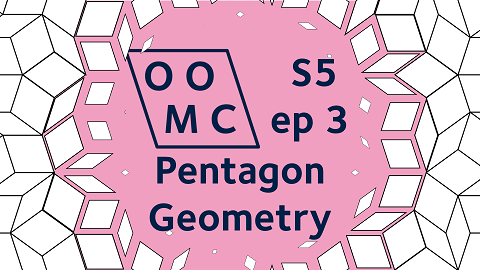Season 5 Episode 3

Pentagons are often overlooked because they don't tessellate nicely. In this episode we put that right by devoting a whole episode to the geometry of the pentagon.
Further Reading
Pentagon geometry
Which other regular shapes can we draw with just a pair of compasses and a straightedge? You probably already know how to draw a regular triangle, square, and hexagon with compasses and straightedge (if not, try it now!). Now that we can draw a pentagon too, we can draw a decagon (which I’m going to call a 10-gon because I’m about to run out of Greek prefixes). We can do that by drawing a pentagon and bisecting the angle at the centre. We could do that again to draw a 20-gon then a 40-gon and so on. So perhaps a good question is;
“Which regular polygons with a prime number of sides can we draw with just a pair of compasses and a straightedge?”
We’ve seen that we can do a 3-gon (triangle) and a 5-gon (triangle)
Gauss proved that we can also construct a 17-gon.
We can also do a 257-gon or a 65537-gon. Nobody knows if there are any other polygons with a prime number of sides that we can construct!
These numbers are called Fermat primes. First I need to tell you that a Fermat number is a number of the form $2^{2^n}+1$ so that’s a power of 2, then two to the power of that, then add one. These numbers get large very quickly. If that number is prime, then that’s a Fermat prime. We only know five Fermat primes; $3$, $5$, $17$, $257$, $65537$. We haven’t found any more (despite looking) and there might not be any more. Or there might be infinitely many more. Or just a few more. We don’t even know if there are infinitely many composite (not prime) Fermat numbers. So the question above is “open”; nobody currently knows the answer.
A polygon that we can construct is called a constructible polygon. A regular $n$-gon can be constructed with compass and straightedge if and only if $n$ is a power of 2 or the product of a power of 2 and any number of distinct Fermat primes. For more see this Wikipedia page
Pascal’s triangle
Because we just can’t escape Pascal’s triangle this season, that Wikipedia page has a section "connection to Pascal’s triangle" that is absolutely mysterious to me. Seriously, I have no idea how that bit of mathematics could possibly be true.
Spiral of Pythagoras
On the livestream I said this was an Archimedean spiral, sorry. I’m always mixing up those two mathematicians. This is the spiral that’s made by gluing together a sequence of right-angled triangles, building each new triangle by constructing a right angle, walking a distance of 1, and connecting that new point to the origin. I made you a GIF to illustrate this, but you should have a go at drawing it with pencil and paper before looking at my GIF; pythag_spiral.gif.
To make things even more confusing, this is usually referred to as a Spiral of Theodorus. In my defence, for large $n$ this is an approximation to an Archimedean spiral.
Carlyle circle
Solving quadratic equations with geometry: see Wikipedia for more!
If you want to get in touch with us about any of the mathematics in the video or the further reading, feel free to email us on oomc [at] maths.ox.ac.uk

